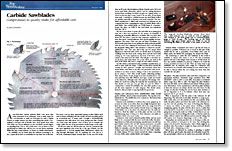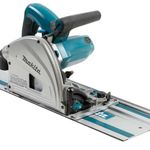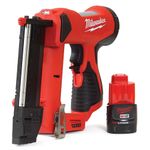All About Saw Blades

Although blades for a miter saw or a tablesaw represent a sizable investment, they have a great deal to do with the quality of cut and how much attention a sawn edge will need after it comes off the saw. Blade design varies, depending on whether the blade is used for ripping or crosscutting, but most blades these days are carbide tipped rather than made from high-speed steel.
What Counts:
• Number and pattern of teeth
• Blade flatness
• Quality and amount of carbide tips
Rip vs. crosscut
Rip blades have fewer teeth than crosscut blades: a 10-in. rip blade typically has 24 teeth compared with a cutoff blade with as many as 80. Many woodworkers opt for combination blades with 40 to 60 teeth that can be used for either ripping or crosscutting. That saves the trouble of switching blades every time a different type of cut is made. More than a dozen brands are readily available, at prices from about $35 to $120. Performance varies considerably, although the most expensive blades usually make smoother cuts than economy blades.
Tooth types differ
There are a few common tooth designs. On an alternate top bevel blade (ATB), alternating teeth are beveled in opposite directions to cut wood fibers cleanly when crosscutting. For faster rip cuts, a flat-topped raker (ATB & R) can be added between sets of beveled teeth. Another type of blade, called a triple chip grind, is designed for chip-free cuts in hard wood, plastics and plastic laminated to wood, such as melamine. Within these basic parameters, manufacturers can adjust hook and bevel angles and make other modifications for specific applications. High hook angles, for instance, make for faster but rougher cutting.
Materials and sizes
Standard saw blades make a kerf 1/8 in. wide. Thin, or narrow, kerf blades have a slightly thinner plate so they take less power to operate and consume less material. They are, however, not as stiff as a standard blade. Manufacturers use a variety of plate designs to minimize warping, noise and heat build-up, but plate flatness is a key factor in overall blade quality. Another is the carbide that’s used for cutting tips. Better-quality carbide is more durable, and there should be enough of it to allow for a number of sharpenings before the blade must be scrapped.
Dadoes for wide kerfs
Dado blades are sets of specialized saw blades designed to cut flat-bottomed dadoes and rabbets as well as furniture joinery. A set consists of an inside and outside cutter plus a number of chippers that go in between them. By varying the number and thickness of the chippers, grooves from about 1/4 in. to about 13/16 in. wide can be cut. Dado sets, used on tablesaws and radial-arm saws, are 6 in., 8 in. or 10 in. in size.
On a standard dado set, the width of cut is fine-tuned with shims that are added between the blades. Another approach is to add an adjustable hub on one of the outside cutters that can be turned in or out by hand or with a wrench. A third type is called a “wobble” dado, but these cut a slightly rounded rather than a flat bottomed groove and have limited usefulness. Just like regular saw blades, dadoes come in different price ranges and overall quality.
Bandsaw blades
What makes a bandsaw blade right for the job depends on the material you’re cutting, the type of saw you own, and whether the cut is straight or curved. Blades are sold by their length, in inches, which varies from machine to machine. There are carbon steel, bi-metal, and carbide blades to choose from, as well as a variety of tooth configurations and blade widths.
Blade size matters
For straight-line cuts, the best choice is the widest blade that your bandsaw can tension correctly, which is probably 1/2 in. for most mid-size bandsaws found in small woodshops (you may want to replace a worn tensioning spring on an older saw). A wide blade offers the most stability for resawing. Narrow blades are used when cutting a curve; the tighter the radius, the narrower the blade. A 3/8-in. blade, for example, will handle a radius of about 1-1/2 in. while a 1/8-in. blade will handle a 1/8-in. radius.
Teeth configuration affects the cut
Blades are designated by the number of teeth per inch (tpi) as well as width and length. Finer-tooth blades make smoother cuts, but coarser blades cut more aggressively. For resawing, a 3 tpi or 4 tpi blade hook or skip-tooth blade is a good choice. Skip-tooth blades have wider spacing and won’t clog as easily. Hook-tooth blades cut faster than skip-tooth or standard blades, but the cuts aren’t quite as smooth.
Steel quality affects sharpness
Blades made from carbon steel are the most economical, but they also dull rapidly when they get hot enough. Bi-metal blades are made mostly with ordinary steel blades but have teeth of high-speed steel, which stays sharp even when it gets hot. The most expensive blades have carbide-tipped teeth just like tablesaw blades. They stay sharp much longer and are probably worth the money if you intend to do a lot of resawing in dense, hard woods.
Fine Woodworking Recommended Products

Makita SP6000J1 Track Saw

Milwaukee M12 23-Gauge Cordless Pin Nailer

Ridgid EB4424 Oscillating Spindle/Belt Sander





















Log in or create an account to post a comment.
Sign up Log in